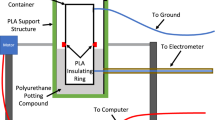Abstract
FOR charge diameters greater than 1 in., the detonation velocity of ‘confined’ T.N.T., that is, T.N.T. cast in metal tubes, increases only very slightly with increasing charge diameter, indicating a very short reaction-time (∼ 10−8 sec.) for the primary decomposition process of this explosive. The experimental results already reported1 suggested that this small change might be associated with the existence of the ‘surface chilled’ layer which would be present in all heavily confined charges and would vary little in character with changes in charge diameter. It was decided, therefore, to re-investigate the velocity–charge diameter relationship for T.N.T. under conditions of charge cooling such that very different degrees of surface chilling were operative during the initial solidification phase.
This is a preview of subscription content, access via your institution
Access options
Subscribe to this journal
Receive 51 print issues and online access
$199.00 per year
only $3.90 per issue
Buy this article
- Purchase on Springer Link
- Instant access to full article PDF
Prices may be subject to local taxes which are calculated during checkout
Similar content being viewed by others
References
Tranter, T. C., Nature, 174 81 (1954).
Dautriche, C.R. Acad. Sci., Paris, 143, 641 (1906).
Jones, H., and Stickland, Ministry of Supply unpublished report.
Author information
Authors and Affiliations
Rights and permissions
About this article
Cite this article
EVANS, W., TRANTER, T. ‘Reaction Time’ of Cast Trinitrotoluene as a Function of the Rate of Charge Cooling. Nature 174, 1100–1101 (1954). https://doi.org/10.1038/1741100a0
Issue Date:
DOI: https://doi.org/10.1038/1741100a0
Comments
By submitting a comment you agree to abide by our Terms and Community Guidelines. If you find something abusive or that does not comply with our terms or guidelines please flag it as inappropriate.



